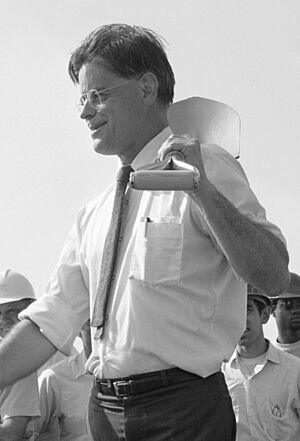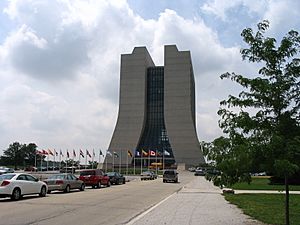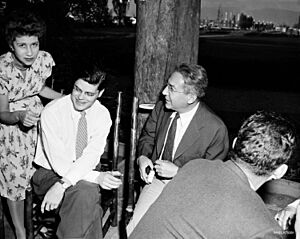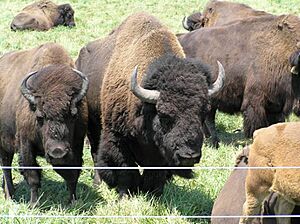Robert R. Wilson facts for kids
Quick facts for kids
Robert R. Wilson
|
|
|---|---|

Wilson at the Fermilab groundbreaking ceremony
|
|
| Born | March 4, 1914 Frontier, Wyoming, U.S.
|
| Died | January 16, 2000 (aged 85) Ithaca, New York, U.S.
|
| Education | University of California, Berkeley (BA, MS, PhD) |
| Awards |
|
| Scientific career | |
| Fields | Physics |
| Institutions | |
| Thesis | Theory of the Cyclotron (1940) |
| Doctoral advisor | Ernest Lawrence |
| Signature | |
 |
|
Robert Rathbun Wilson (born March 4, 1914 – died January 16, 2000) was an American physicist. He was known for his work on the Manhattan Project during World War II. He was also a talented sculptor. Later, he became the first director of the Fermi National Accelerator Laboratory (Fermilab) from 1967 to 1978.
Wilson studied at the University of California, Berkeley. He earned his doctorate under Ernest Lawrence. His work involved developing the cyclotron, a type of particle accelerator. After this, he worked at Princeton University. There, he helped separate different types of uranium atoms.
In 1943, Wilson joined the Manhattan Project. This was a secret project to build the first atomic bomb. He led the Cyclotron Group at the Los Alamos Laboratory. After the war, Wilson taught at Harvard University and then at Cornell University. At Cornell, he helped build several electron synchrotrons, which are also particle accelerators.
In 1967, Wilson became the director of the National Accelerator Laboratory, which later became Fermilab. He finished the huge science facility on time and within budget. He also made sure it looked beautiful. The main building was designed to look like a famous French cathedral. He even brought a herd of American Bison to live on the restored prairie at the site. He left Fermilab in 1978 because he felt the government wasn't giving enough money for science.
Contents
Early Life and Education
Robert Rathbun Wilson was born in Frontier, Wyoming, in 1914. His parents were Platt Elvin and Edith Elizabeth Wilson. He had an older sister named Mary Jane. When he was eight, his parents separated. Robert often lived on cattle ranches and changed schools many times. One school he attended was the Todd School in Woodstock, Illinois.
In 1932, Wilson started at the University of California, Berkeley. He earned his Bachelor of Arts degree in 1936. He then joined Ernest O. Lawrence's Radiation Laboratory. This lab was a top place for physics research. Wilson earned his PhD in 1940. His research was about the "Theory of the Cyclotron." That same year, he married Jane Inez Scheyer.
Wilson sometimes had disagreements with Lawrence, who was very strict about money. Wilson was even fired twice from the lab! Once, he lost a small rubber seal, which stopped a cyclotron demonstration. He was hired back but then melted an expensive pair of pliers while welding. He was fired again. Even though he was offered his job back, he decided to go to Princeton University instead.
Work on the Manhattan Project
At Princeton, Wilson took over a project to separate uranium atoms. This was important for making an atomic bomb. They developed a device called the "isotron." It used an electric field to separate uranium-235 from uranium-238.

During World War II, the Princeton project ended. In 1943, J. Robert Oppenheimer opened a secret lab for the Manhattan Project in Los Alamos. Wilson and many of his team joined. Wilson later said they "signed up, en masse, to go to Los Alamos."
Wilson moved to Los Alamos with some of his Princeton staff. He also brought Harvard University's cyclotron with him. Oppenheimer made him the head of the Cyclotron Group (R-1). Wilson was only in his late twenties, making him the youngest group leader. The cyclotron was used to measure how neutrons interacted with plutonium.
In August 1944, Oppenheimer reorganized the lab. Wilson became the head of the Research (R) Division. He oversaw four groups, including his own Cyclotron Group. In 1945, his division also helped create tools for the Trinity nuclear test. This was the first test of an atomic bomb. Wilson even helped stack explosives for a smaller test before Trinity. He was also active in the Los Alamos community.
In May 1945, Nazi Germany surrendered. This made some scientists wonder if they should continue building the bomb. Wilson raised this question. But Major General Leslie Groves, the project director, did not like the idea. Later in life, Wilson said he regretted not trying harder to stop the bomb's development after Germany surrendered. After the Trinity test, while others celebrated, Richard Feynman saw Wilson looking sad. Wilson told Feynman, "It's a terrible thing that we made."
After the atomic bombing of Hiroshima and Nagasaki, Wilson helped start the Association of Los Alamos Scientists (ALAS). This group asked for international control of atomic energy. Their petition was given to President Harry S. Truman.
After World War II
After the war, Wilson also helped create the Federation of American Scientists. He was its chairman in 1946. He then became a professor at Harvard. He spent eight months designing a new cyclotron for Harvard. At Harvard, Wilson wrote an important paper about using fast protons for medical treatment. This started the field of proton therapy.
Cornell University
In 1947, Wilson became a physics professor at Cornell University. He also directed its new Laboratory of Nuclear Studies. At Cornell, Wilson and his team built four electron synchrotrons. He explained their goal in a 1948 report:
The most important problems of nuclear physics... are: What are the tiny particles that make up atomic centers, and what forces hold them together? We also want to understand how electricity works at very high energies. Our experiments will try to answer these questions. We hope to create artificial mesons (tiny particles) and study how they interact with atomic centers. We will also explore how high-energy electrons interact with other electrons and protons. This will help us find a correct theory of electricity at high energy.
In 1952, Wilson started building a larger synchrotron. This machine created artificial K mesons and rho mesons. It also tested theories about electricity at very small distances. The last machine he built at Cornell was a 12 GeV synchrotron. It is still used today to help power the Cornell Electron Storage Ring (CESR). This lab is now called the Wilson Synchrotron Laboratory.
Wilson was one of the first physicists to use Monte Carlo methods. These are computer simulations used to model how particles behave. He also invented the quantometer to measure the strength of high-energy X-ray beams.
Leading Fermilab

In 1967, Wilson took a break from Cornell. He became the director of the new National Accelerator Laboratory in Illinois. This was planned to be the biggest particle accelerator ever built. In 1969, Wilson had to explain why this multi-million dollar machine was needed to a government committee. He said it was not for national security. Instead, he explained:
It only has to do with the respect with which we regard one another, the dignity of men, our love of culture... It has to do with: Are we good painters, good sculptors, great poets? I mean all the things that we really venerate and honor in our country and are patriotic about. In that sense, this new knowledge has all to do with honor and country but it has nothing to do directly with defending our country except to help make it worth defending.
Thanks to Wilson's strong leadership, Fermilab was finished on time and under budget. He promised the Atomic Energy Commission chairman that he would not spend more than $250 million. The main part of the facility was a four-mile-long accelerator. Wilson then started designing an even more powerful accelerator called the Tevatron. In 1974, the lab was renamed the Fermi National Accelerator Laboratory, or "Fermilab," after Enrico Fermi.
Wilson had studied sculpture in Italy in 1961. He wanted Fermilab to be a beautiful place to work. He believed that a pleasing environment would help people work better together. He personally worked to make sure it didn't look like a typical "government lab." He played a key role in its design and buildings. He also created a restored prairie around the facility. In 1969, he brought a bull and four cows to start a herd of American Bison there.
The site also had ponds. The main building was designed to remind people of the Beauvais Cathedral. Fermilab also shows off Wilson's sculptures. These include "The Mobius Strip" and "The Hyperbolic Obelisk." Another metal sculpture, "Topological III," is at the Harvard Science Center. In 1980, Fermilab's main building was named Robert Rathbun Wilson Hall in his honor.
Wilson was the director of Fermilab until 1978. He resigned because he felt the government was not giving enough money for science. He then taught at the University of Chicago and later at Columbia University. He retired in 1983 and moved back to Ithaca, New York.
Awards and Honors
Robert Wilson received many awards. These include the Elliott Cresson Medal in 1964. He also received the National Medal of Science in 1973. In 1984, he was given the Department of Energy's Enrico Fermi Award. He was chosen to be a member of the National Academy of Sciences. He was also president of the American Physical Society in 1985. In 1986, he received the Golden Plate Award.
Later Life and Death
Wilson had a stroke in 1999 and never fully recovered. He passed away on January 16, 2000, at age 85. He died at a nursing home in Ithaca, New York. He was buried at the Pioneer Cemetery on the Fermilab site. He was survived by his wife, Jane, his three sons, Daniel, Jonathan, and Rand, and his sister, Mary Jane Greenhill. His papers are kept at the Cornell University Library.



